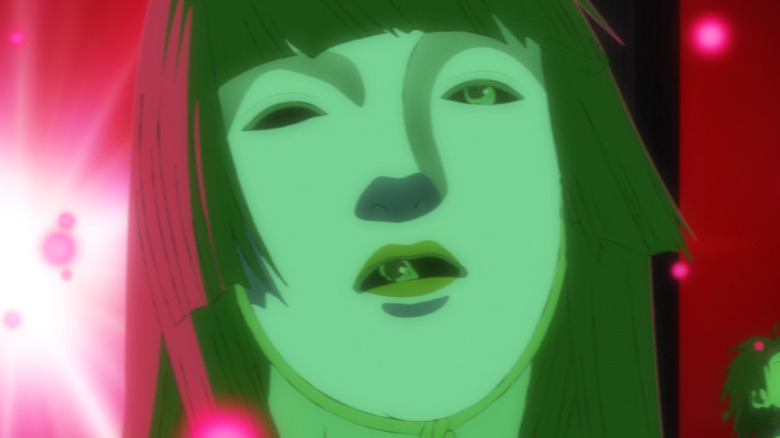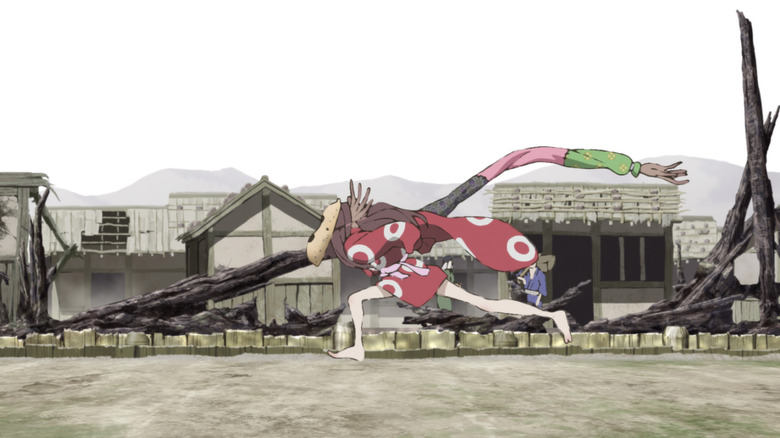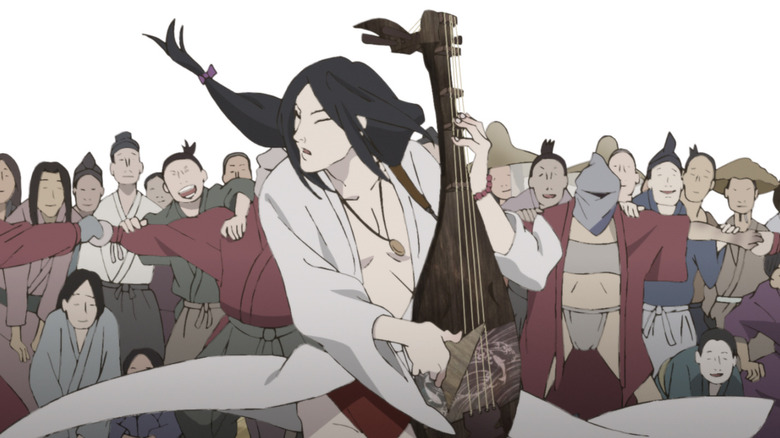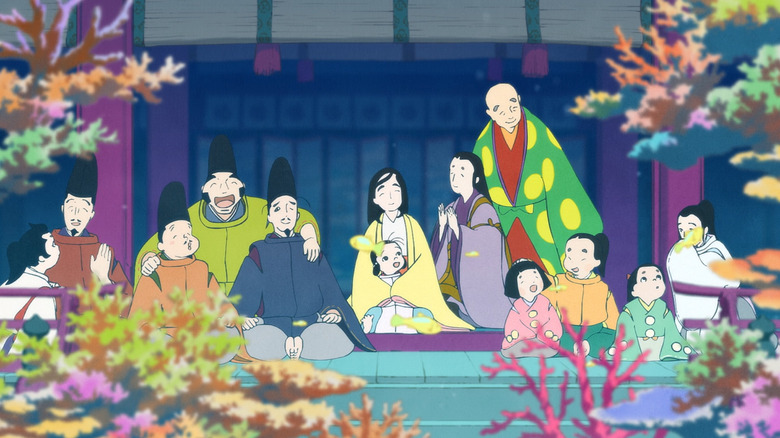Inu-Oh Director Masaaki Yuasa Talks Japanese History And Rock 'N' Roll - Exclusive Interview
The most strikingly original and possibly the best anime movie of the year, "Inu-Oh" reimagines one of the founders of noh theater as a glam rock star singing the stories of dead Heike warriors to cure himself of a magical curse. Inu-Oh (the name means "king of the dogs") goes on his rocking tour of 14th-century Japan with a blind biwa player originally named Tomona (he goes by various different names over the course of the story). With incredible musical performances, stellar animation, and a story about speaking truth to power, "Inu-Oh" is yet another masterpiece from director Masaaki Yuasa, whose past work includes "The Tatami Galaxy," "Devilman Crybaby," and "Keep Your Hands Off Eizouken!"
Looper got the chance to speak with Yuasa in advance of the film's release on home video and digital platforms, which will also include the debut of its English dub. Speaking with us via an interpreter, Yuasa discussed a wide range of topics, including building connections between the fictional past and the real present, the ambiguous relationship between the film's main characters, and what other anime he's enjoyed the most this year.
Planning out Inu-Oh's opening scenes
The opening scenes of "Inu-Oh" are a lot to take in the first time you watch the movie. How did you go about deciding how you started the story?
The opening is a lot, like you said, and we are going backward to 600 years ago, so time is going backward. The scenery, the background is going back to 600 years ago, and it's going from slow to quicker and quicker. It's depicting how [current] noh performance is really slow, but back then, apparently, it used to be a lot faster.
Also, the coloring [is based on the] Heike clan and Genji clan, the two clans that fought in [1185 at the Battle of] Dan-no-ura, which is an important part of this "Inu-Oh" story. The Heike clan and Genji clan had the colors red and white. So in the entire opening, you see some red and white colorings in the athletic day in a school [and at] Kohaku Utagassen, the big year-end music event in Japan that everybody watches on TV. It's called Red, White, so female [singers wear] red, male singers [wear] white, and they challenge each other. I wanted to express all that in the opening.
Dreams of musical stardom throughout history
One of the things that makes this movie unique is that both of the main characters have disabilities. What was your interest in dealing with this subject matter?
I wanted to have this really modern rock-and-roll music, although it's different. Everybody in this era doesn't even imagine that was actually played back then, but you never know. So the people would enjoy similar things, now and back then. I wanted to have that connection. [The] Muromachi era [was in the] 14th century. It's a long, long time ago, but maybe they enjoyed similar music [to what] we enjoy now.
In terms of [the] two protagonists, they had deformities or were physically disabled. Even in that era, 600 years ago, [it was] said that they could never be stars. It seemed impossible, but then they made it happen. They overcame their misfortune [and] their adversities. Back then, everybody wanted to be stars, these performing artists, and they had to have good music and good acts. And these two somehow [ended] up becoming stars together.
Some of the musical sequences in this movie are very long, almost mini-operas. "The Whale" is seven minutes long. "Dragon Commander" is 13 minutes. Is it harder to plan out the choreography for such epic songs?
Actually, it wasn't really difficult. Because we had to tell the story, each song had a story of the Heike clan. In order to tell the whole story, it was pretty much naturally long. Naturally, the music had to be long. Do[ing] that, wardrobe designing, [and] all these tricks that we made happen [were] a lot of fun. [With the] dance also, I didn't really find it difficult. It was more of [a feeling of] enjoyment.
What was challenging [was that] the music would be enhanced more and more and get more and more exciting. [When] the music goes up, we had to have [the] animation also go up higher and higher in terms of the passion and the enthusiasm. That was a little difficult.
Were there any songs or other scenes that got cut from the movie?
Not really. It was a lot to even just make the music that you hear in movies, so we didn't leave out anything.
Inu-Oh and Tomona play around a lot with gender presentation, and their music brings to mind queer rock stars, like Freddie Mercury. When watching the film, there were times I was wondering if the characters were gay lovers. Do you see their bond as romantic or just as friendship?
I actually avoided making it clear. I wanted it to be [a] gray area so whoever watches this movie can decide on their own. Just giving the personality to these characters — I thought that was enough.
The Heike Story, Tatami Galaxy, and other anime favorites
Around the same time "Inu-Oh" premiered at the Venice Film Festival last year, Science SARU also released "The Heike Story" TV series, dealing with a similar point in history. Were these two anime designed to accompany one another?
I believe that the producing company, Asmik Ace, considered that because the "Inu-Oh" story/Heike clan story was maybe not that [well] known yet. So they want[ed] to make it happen around the same time so that everybody in the audience would have [an] easier [time] understanding both of [them].
Also, the author of "The Tale of Heike Clan: Inu-Oh" — before he released that book, he actually released another book that was the translation of the original Heike clan story from history.
Science SARU also recently made a sequel to your show, "The Tatami Galaxy," though you didn't direct the sequel yourself. Would you ever personally want to direct any sequels to anime you've worked on in the past?
I would accept it, but [the] thing is, [for] this "Tatami Galaxy," the sequel in particular, I don't think the timing was right.
As far as timing goes, I know you announced that after "Inu-Oh," you were on a break from directing. How much longer do you expect to be on break, and do you have any ideas of what you want to make when you return?
It's up to whatever happens. I'm not really determined to go one way or another right now, but I'm trying ... Well, it doesn't look like I'm working, but I am working, doing this promotional work for "Inu-Oh." And I am planning other stuff for the future as well.
Out of all the anime you've worked on, do you have any personal favorites?
[That's] sort of like, which child of yours do you favor?
I guess it might be easier to ask about other people's anime or movies. Have you watched any movies or anime recently that you recommend?
It's called "Sing a Bit of Harmony" in English. "Ai no Utagoe wo Kikasete" is [the] Japanese title. So it's a musical, like "High School Musical," with AI. It's not produced using AI, but it's a story of AI in high school, and they're singing and dancing.
"Inu-Oh" will be available on digital platforms on December 20 and on Blu-ray and DVD on January 24.
This interview has been edited for clarity.



